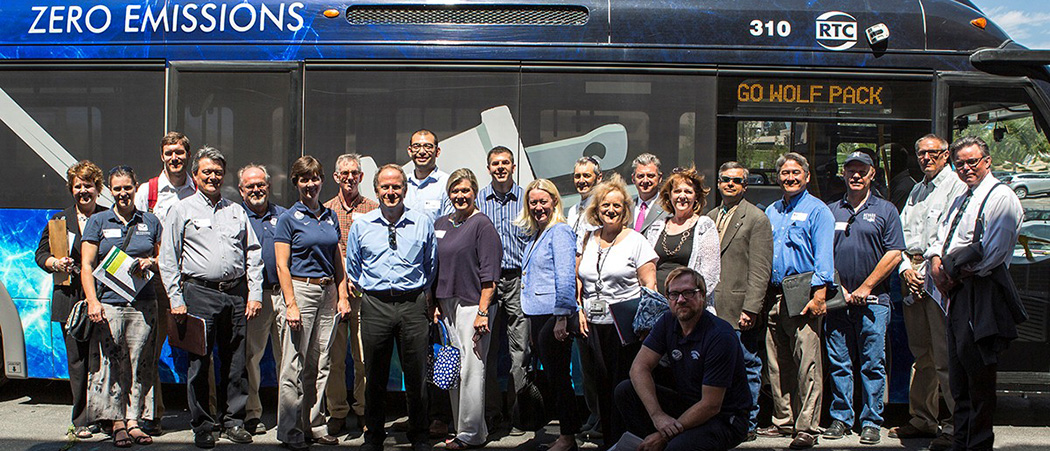The wheels on the bus are very green. So green in fact, they don't require gasoline, oil or other emissions control devices. It is on this bus, one of four new Regional Transportation Commission electric-battery buses, that more than 25 representatives from the University of Nevada, Reno, City of Reno, Governor's Office of Energy, RTC and Keep Truckee Meadows Beautiful learned of the many sustainable efforts taking place in the northern Nevada community.
The group was brought together by the University to showcase renewable efforts as part of the Summer of Sustainability, a series of community events offering outreach and education. Designed to highlight the University's significant conservation efforts, which have been supported by a $951,000 grant from the U.S. Department of Energy in 2009, the University's Academy for the Environment has been hard at work on this demonstration project, helping to advance the University's sustainable efforts in areas that offered the most benefit.
Before boarding the bus, the group toured the Mathewson-IGT Knowledge Center's Reused + Recycled = Art exhibit where more than 100 pieces of art submitted by University students, Washoe County high school students and local artists are on display. Projects submitted for consideration were required to have at least 80 percent reused or recycled materials.
After the art tour, the group walked through the Brain J. Whalen Parking Complex to see the LED lighting replacement project, which saves the University approximately $125,000 per year in electrical costs according to John Sagebiel, assistant director of the University's environmental programs. The group also got a look at the two Electric Vehicle Charging Stations, allowing electric vehicle owners to charge their cars while working, studying or visiting campus.
At the Valley Road Field Labs & Greenhouse Complex, the group's next stop, Grant Cramer, agriculture professor, talked about the work at the experimental vineyard and fermentation lab; John Cushman, foundation professor in biochemistry, showed how plants being studied at the University can be turned into bio-fuel; and Jennifer Ott, High Desert Farming Initiative project manager, presented the group with a tour of the Hoop Houses, which grow food for Nevada Dining on campus and is sold in local farmers' markets.
"All of these programs give us the opportunity to highlight the work we are doing to promote sustainability locally and among our students," Kevin Carman, executive vice president and provost at the University, said. "We're constantly moving toward a more sustainable campus, toward being more energy conscious and toward reducing our costs while at the same time, reducing our carbon footprint."
Back on the bus, the group learned about community sustainability efforts as they drove through a number of key northern Nevada projects including the RTC's natural gas fueling station; Corporation Yard, home to solar panels and natural gas vehicles; Waste Management, where a new EcoCenter will open and be able to accommodate the volume of recycling generated from the Single-Stream Recycling Program; and Lost City Farms, a local food sourcing co-op.
Jason Geddes, environmental services administrator at the City of Reno, talked about the work being done between the City of Reno, University and RTC to create a downtown corridor, making downtown biking and foot traffic more accessible to and from the University.
Geddes also offered that the City's famed Reno Arch is made up of 2,076 bulbs, all of which have been converted to LED lights. The City is expected to realize annual savings exceeding $1.6 million thanks to its Energy Efficiency and Renewable Energy initiative, of which the Reno Arch was a part. The initiative has received national attention for its energy conservation and renewable energy efforts.
"Reno is the first city in the nation where a major municipality has been able to successfully integrate American Recovery and Reinvestment Act funds and rebates to create a fully self-funded project," Geddes said. "This annual savings will be used to pay off bonds, making no impact on the City's general fund."
As the tour concluded, one thing was evident: while efforts like those showcased on the tour continue to move the needle forward, there is still a lot of work to be done.
"When we first started this project, we titled it 'Walk the Talk'," Mike Collopy, assistant vice president for research and co-principal investigator of the sustainability grant, said. "A number of projects that already existed around sustainability and our efforts have helped move the needle. The Summer of Sustainability is a partnership with the Mathewson-IGT Knowledge Center tied to the educational piece of the program, which we believe offers continued success, education and enforcement for what we're doing."
The Summer of Sustainability continues through September. In addition to continued exhibit viewing, there will be a speaker, panel discussions and film screenings. For a complete list of events, visit http://campusguides.unr.edu/sos.
NevadaToday
University sustainability efforts ‘walk the talk’
University of Nevada, Reno, along with City of Reno and community representatives, highlight green efforts taking place on campus and throughout the City as part of Summer of Sustainability’s Bus Tour

A group of local community and University leaders board one of four RTC Electric Buses to tour community sustainability efforts.











